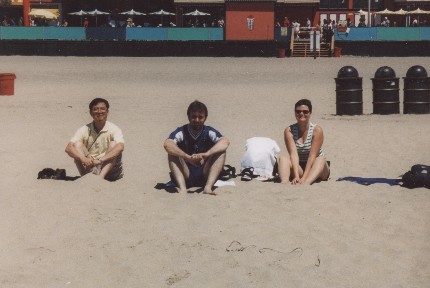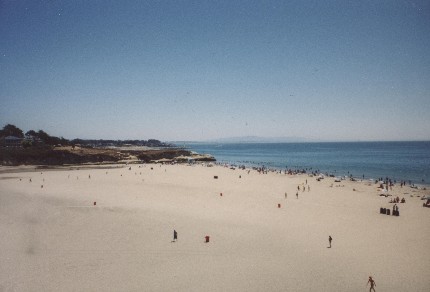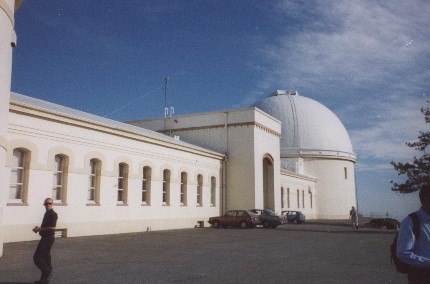Santa Cruz, California, August 2003

left-right ~ Sijiong, David and Clare burning in the Californian sun
In the summer of 2003 Clare, David, Heather and Sijiong travelled to Santa Cruz California for an intensive week long course in Advanced Adaptive Optics. The course, run by the Centre for Adaptive Optics (CFAO), is an annual event which alternates between the introductory and advanced course year to year.
Santa Cruz is a beautiful little town on the Californian coast with miles of golden sandy beach and spectacular views of the Pacific Ocean. It is a popular spot for surfers and is only an hour long drive from San Francisco. The group took a day trip there and saw the sights of Fisherman's Wharf, and views of the Golden Gate bridge and the infamous Alcatraz. There was also time to sample the famous (and delicious!) sour dough bread that they make there. A local specialty is to take a loaf of sour dough bread, hollow it out, and use it as a bowl for thick clam chowder. Clare was adventurous enough to try some and assured us all that it was very tasty!

Santa Cruz beach and the magnificent Pacific Ocean
The CFAO arranged a trip to the Lick Observatory on nearby Mount Hamilton which was a very exciting opportunity. In the heart of the Diablo range, east of San Jose, the observatory sits at a height of 4200' (1.2km). The observatory is the legacy of James Lick, the eccentric millionaire who is buried beneath one of the large telescopes there. When Lick was in his last years he was obsessed with leaving a lasting monument. He owned a large portion of San Francisco and wanted to build a pyramid (right in downtown Market St!) larger than the Great Pyramid of Egypt! However, he was finally convinced that an observatory would be a much better idea. James Lick and the observatory have a very interesting history, to read more about this visit the Lick website.
We were given a tour of the Lick facilities which ended with a nights observing using the 36" refractor. The dome that houses the telescope is an incredible construction in itself. The wooden floor is on hydraulics and can be lifted up and down as the angle of the telescope changes. This allows the observer to look directly through the eyepiece. Sitting in the red-lit chilly dome and looking up at the stars we all felt very privileged to have been given this opportunity.
A highlight of the trip to Lick Observatory was the chance to actually do some observing. We were there just one week before Mars was the closest to the Earth that it will ever be in our lifetimes (on the 27th of August). In fact observations of the opposition of Mars began in late 2002, so we were particularly lucky to be there at the end of August to see the climax of this long awaited event. Using the 36" refractor (under which James Lick is buried) we were all given the chance to observe Mars directly through the eyepiece, echoing the experiences of visual observers of the late 19th and early 20th century. It was a magical once-in-a-lifetime experience. You can visit the Lick webpage to read more about the 2003 opposition of Mars.

The Lick Observatory at the summit of Mt Hamilton, California
back to top
Just for fun
A little peek into the lighter side of life within the Heriot-Watt Waves & Fields group.
Word of the Week:
Gallivanting
Or: